Nevada

 Our aunt, Linda Cole was always a vibrant, happy person. She had a laugh that would light up a room. We didn’t see Linda and her husband Bobby as much as some of the rest of the family, because they lived for many years is Kennebec, South Dakota, where they owned a little “mom and pop” hotel. To visit them and their children, Sheila and Pat meant a trip of at least a weekend, and better yet a three or four day weekend. The drive was long enough to where you had to stay the night. The nice thing was that since they owned a hotel, you always had a place to stay…and they never would let us pay them for the room. They just liked that we wanted to come for a visit at least once a year.
Our aunt, Linda Cole was always a vibrant, happy person. She had a laugh that would light up a room. We didn’t see Linda and her husband Bobby as much as some of the rest of the family, because they lived for many years is Kennebec, South Dakota, where they owned a little “mom and pop” hotel. To visit them and their children, Sheila and Pat meant a trip of at least a weekend, and better yet a three or four day weekend. The drive was long enough to where you had to stay the night. The nice thing was that since they owned a hotel, you always had a place to stay…and they never would let us pay them for the room. They just liked that we wanted to come for a visit at least once a year.
When the hotel burned down, after being struck by lightning, they pretty much lost their livelihood. To rebuild made no sense, because there was a chain motel that was right off the interstate, meaning that fewer people actually came into Kennebec to the “mom and pop” that was located there. Times were changing, and they would have to change with them. The solution was a move to Winnemucca, Nevada, where they found jobs working in the casinos. I think they were happy to be free of the hotel, because it meant no more cleaning rooms and limiting their vacation times to the months when no one was traveling, including them. Winters in South Dakota can be a special kind of brutal, and travel was hazardous. Linda and Bobby found that the warmer, dryer climate of Nevada really suited them, so they stayed for the rest of their lives. They never “struck it rich” but they had a good time. Their move to Nevada meant that fewer people went for visits, and that is sad. It was a little further, so it was hard. Her sister, Joann and brother-in-law visited the most.

 Bobby passed away from cancer on May 30, 2014, at the age of 71, and Linda passed away unexpectantly on September 22, 2016, from a heart attack at the age of 69. We were shocked and saddened by their passing. They were, in my opinion, far too young. I think Linda lost the will to live after Bobby passed. They were such a part of each other. Their marriage was on that was made in Heaven, and they never doubted their love for each other for a minute. Today would have been Linda’s 78th birthday. Happy birthday in Heaven, Linda. We love and miss you very much.
Bobby passed away from cancer on May 30, 2014, at the age of 71, and Linda passed away unexpectantly on September 22, 2016, from a heart attack at the age of 69. We were shocked and saddened by their passing. They were, in my opinion, far too young. I think Linda lost the will to live after Bobby passed. They were such a part of each other. Their marriage was on that was made in Heaven, and they never doubted their love for each other for a minute. Today would have been Linda’s 78th birthday. Happy birthday in Heaven, Linda. We love and miss you very much.
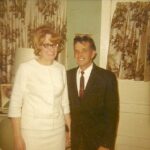
 When my husband, Bob’s uncle, Bobby Cole comes to mind, I am taken back to the days when my girls, Corrie Petersen and Amy Royce, were little. Whenever we took a trip to see Bobby and Bob’s aunt, Linda Cole, we always had a great time. The girls got to play with their cousins, Sheila and Pat, and we enjoyed visiting and playing cards with Linda and Bobby. In those days, they lived in Kennebec, South Dakota. It was a tiny little town, with very little to do, so having visitors was a big deal to them.
When my husband, Bob’s uncle, Bobby Cole comes to mind, I am taken back to the days when my girls, Corrie Petersen and Amy Royce, were little. Whenever we took a trip to see Bobby and Bob’s aunt, Linda Cole, we always had a great time. The girls got to play with their cousins, Sheila and Pat, and we enjoyed visiting and playing cards with Linda and Bobby. In those days, they lived in Kennebec, South Dakota. It was a tiny little town, with very little to do, so having visitors was a big deal to them.
Linda and Bobby owned a hotel, and there were a few guests, but not really very many. It was like they owned a bed and breakfast…for us anyway. The rest of the guests had to go somewhere else for their breakfast. Bummer for them!! The visit was always so relaxing. The small-town feel was always there, and really, I loved it. I wouldn’t want to live in a small town all the time, but as an annual getaway, it was nice. I suppose it was the break from the everyday that held the majority of the appeal. We didn’t get to see Linda and Bobby much, so having the unhurried time to visit was a rare treat. They were always so full of laughter and fun.
A few years later, their hotel was struck by lightning during a summer storm, and it burned to the ground. After 
 the fire, they made the decision to get out of the hotel business, and to get out of Kennebec. That was when they moved to Winnemucca, Nevada, and for the most part the annual trips stopped. Winnemucca was too far away to make it a weekend trip, like we could with Kennebec. I was always sorry to see those trips end. It was rather like the end of an era. The only thing that was more sad was when Bobby passed away, and then when Linda passed away. I will always miss them. They were a very fun couple. Today would have been Bobby’s 81st birthday. Happy birthday in Heaven, Bobby. We love and miss you very much.
the fire, they made the decision to get out of the hotel business, and to get out of Kennebec. That was when they moved to Winnemucca, Nevada, and for the most part the annual trips stopped. Winnemucca was too far away to make it a weekend trip, like we could with Kennebec. I was always sorry to see those trips end. It was rather like the end of an era. The only thing that was more sad was when Bobby passed away, and then when Linda passed away. I will always miss them. They were a very fun couple. Today would have been Bobby’s 81st birthday. Happy birthday in Heaven, Bobby. We love and miss you very much.

 Our government has been known, in its history, to do some things that really were underhanded, and in some cases horrific. The “need” for nuclear bombs naturally facilitated the need for nuclear testing. I think everyone knows that would had to have happened, but on November 1, 1951, the US Army conducted nuclear tests in the Nevada desert that included a “diabolical exercise in which 6500 US Army troops were exposed to the effects of a nearby nuclear detonation and its associated radiation.” When I read that, I was furious. They knew what they were doing, and they did it as an experiment…just to see what would happen to those poor men.
Our government has been known, in its history, to do some things that really were underhanded, and in some cases horrific. The “need” for nuclear bombs naturally facilitated the need for nuclear testing. I think everyone knows that would had to have happened, but on November 1, 1951, the US Army conducted nuclear tests in the Nevada desert that included a “diabolical exercise in which 6500 US Army troops were exposed to the effects of a nearby nuclear detonation and its associated radiation.” When I read that, I was furious. They knew what they were doing, and they did it as an experiment…just to see what would happen to those poor men.
It was called Operation Buster–Jangle. The US Army conducted a series of 7 nuclear tests, that included the November 1st test. In that involuntary one test, the 6500 troops, were dug in foxholes and trenches only 6 miles from an air burst nuclear bomb of 21 kilotons yield. That is about the size of the Nagasaki bomb!! After the soldiers felt the hot nuclear wind blast over them, the wind deposited desert dust in choking clouds upon the men. Then, the soldiers were ordered to get up and march across the blast site to within 900 meters (a little over ½ a mile) of the nuclear “ground zero.” That is incredibly close, and those men were exposed.
The damage done to those men was not well documented, but the US Government later passed the 1990 Radiation Exposure Compensation Act (RECA) to compensate the military veterans exposed to nuclear testing in the 1950’s. The passing of that act is implied acknowledgment of the responsibility of the US government in long term health problems experienced by those troops…without actually placing the blame, and therefore opening the government up to future lawsuits. Basically, the men, were they still alive, or their families, if not, 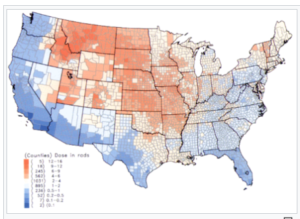
 could theoretically be compensated for their losses. Of course, as many of us have seen with these kinds of cases, the process is very slow, the burden of proof for the men trying to receive compensation is heavy, and the final payout is usually quite low. RECA has awarded over $2.4 billion in benefits to more than 37,000 claimants since its inception in 1990. Still, that’s a small price to pay for the destruction of so many lives.
could theoretically be compensated for their losses. Of course, as many of us have seen with these kinds of cases, the process is very slow, the burden of proof for the men trying to receive compensation is heavy, and the final payout is usually quite low. RECA has awarded over $2.4 billion in benefits to more than 37,000 claimants since its inception in 1990. Still, that’s a small price to pay for the destruction of so many lives.

 Because I love to hike, I am always interested when I see something about a trail I’ve never been on. I can’t say that I’ve hiked an extensive number of trails, but most trails interest me anyway. Sometimes it’s just the area of the country, and my imagination kicking into high gear.
Because I love to hike, I am always interested when I see something about a trail I’ve never been on. I can’t say that I’ve hiked an extensive number of trails, but most trails interest me anyway. Sometimes it’s just the area of the country, and my imagination kicking into high gear.
The Sierra Nevada is a mountain range in the Western United States, located between the Central Valley of California and the Great Basin, with most of it located in the state of California, although the Carson Range spur lies primarily in Nevada. The Sierra Nevada is part of the American Cordillera, an almost continuous chain of mountain ranges that forms the western “backbone” of the Americas. There are literally miles and miles of trails leading to such famous places as Yosemite Valley, King’s Canyon, and Sequoia. Yosemite is the most famous one, and probably the one I would most like to hike. Pictures of the falls often grace the internet as people love the challenge of the hike to Yosemite Falls.
The Sierra Nevada runs 400 miles north-south and approximately 70 miles east–west. Besides the mountain tops, waterfalls, trails, and rivers, the area also boasts the largest tree in the world by volume, known as  General Sherman; Lake Tahoe, the largest alpine lake in North America; Mount Whitney at 14,505 feet the highest point in the contiguous United States; and of course, Yosemite Valley sculpted by glaciers from one-hundred-million-year-old granite, containing high waterfalls. The 28,000 square mile mountain range is home to three national parks, twenty wilderness areas, and two national monuments. These areas include Yosemite, Sequoia, and Kings Canyon National Parks, and Devil’s Postpile National Monument. Many of these places are not accessible by roads, although many are. Still from a hiker’s standpoint, these places are much more interesting if they are approached by trail.
General Sherman; Lake Tahoe, the largest alpine lake in North America; Mount Whitney at 14,505 feet the highest point in the contiguous United States; and of course, Yosemite Valley sculpted by glaciers from one-hundred-million-year-old granite, containing high waterfalls. The 28,000 square mile mountain range is home to three national parks, twenty wilderness areas, and two national monuments. These areas include Yosemite, Sequoia, and Kings Canyon National Parks, and Devil’s Postpile National Monument. Many of these places are not accessible by roads, although many are. Still from a hiker’s standpoint, these places are much more interesting if they are approached by trail.
During the years when people headed west to look for gold, the Sierra Nevada was often the destination of choice. Nevertheless, at that time, traveling across the wild west was very dangerous. Many rich travelers had to hire armed men to protect them on dangerous routes. Thankfully that is not the case today, although, there could be times when we feel the need for armed guards. Nevertheless, I have found that on most trails, people 
 are friendly and kind. Of course, there are always the wild animals, which I have never come across on a trail…perhaps strangely, but true, nevertheless. The biggest “problem animal” I have ever come across was a few cows, who decided that they didn’t want to get off the trail for these strange creatures to pass them. I finally had to slap my hands together, after which, they decided that I was the dangerous one, and they left. One of these days, maybe I will have the opportunity to hike up to Yosemite Falls. I think I would really enjoy it.
are friendly and kind. Of course, there are always the wild animals, which I have never come across on a trail…perhaps strangely, but true, nevertheless. The biggest “problem animal” I have ever come across was a few cows, who decided that they didn’t want to get off the trail for these strange creatures to pass them. I finally had to slap my hands together, after which, they decided that I was the dangerous one, and they left. One of these days, maybe I will have the opportunity to hike up to Yosemite Falls. I think I would really enjoy it.

 It’s hard for me to believe that my husband’s aunt, Linda Cole has been in Heaven for over six years now. I remember so well the times we went to visit her and Uncle Bobby Cole, when they lived in Kennebec, South Dakota when our girls, Corrie Petersen and Amy Royce were little. It wasn’t that going to the small, and I do mean small town, with a population of 334 in the 1980s, that has dwindled to 281 in 2020, but rather that Linda and Bobby were fun people to be around. Pretty much, we sat around and played cards. It wasn’t the card games, but rather the laughter and jokes, the fun conversations, and really just the time together that made the trips fun. There was also the added benefit of cousins, Sheila and Pat for the girls to play with. And the additional added benefit of a vacation with little cost. Of course, that was not why we wet. We went because we liked Linda and Bobby, and the visit was always fun. Following a fire at the hotel that Linda and Bobby owned in Kennebec, they made the decision to move to Winnemucca, Nevada and that was when the yearly visits ended. We did go, but it was further to go, and so not as easy to manage, and so happened less and less often. It was the end of an era.
It’s hard for me to believe that my husband’s aunt, Linda Cole has been in Heaven for over six years now. I remember so well the times we went to visit her and Uncle Bobby Cole, when they lived in Kennebec, South Dakota when our girls, Corrie Petersen and Amy Royce were little. It wasn’t that going to the small, and I do mean small town, with a population of 334 in the 1980s, that has dwindled to 281 in 2020, but rather that Linda and Bobby were fun people to be around. Pretty much, we sat around and played cards. It wasn’t the card games, but rather the laughter and jokes, the fun conversations, and really just the time together that made the trips fun. There was also the added benefit of cousins, Sheila and Pat for the girls to play with. And the additional added benefit of a vacation with little cost. Of course, that was not why we wet. We went because we liked Linda and Bobby, and the visit was always fun. Following a fire at the hotel that Linda and Bobby owned in Kennebec, they made the decision to move to Winnemucca, Nevada and that was when the yearly visits ended. We did go, but it was further to go, and so not as easy to manage, and so happened less and less often. It was the end of an era.
Aunt Linda was the middle child of parents, Robert and Nettie Knox, between sisters Joann Schulenberg and Margee Kountz. There were almost 16 years between Joann (my mother-in-law) and her first younger sister, Linda, and then three years between Linda and Margee. Because of the years between them, Linda became a very young aunt in 1950, when my sister-in-law, Marlyce Schulenberg was born, and she didn’t like it one bit!! It wasn’t that she didn’t love Marlyce, because she did. The problem was that Linda didn’t understand the word…aunt. As a little girl of only 3 years and 7 months. So, being a little girl, she misunderstood the word Aunt and thought she was going to be an ant!! She was absolutely not interested in being a bug!!


Linda was a funny person even as a child, and maybe that was that made her and Bobby so much fun to be around. The funny things she always said, and her infectious laugh were a big part of what I loved about her. In fact, I find that when I think about her, I really miss her to this day. While we didn’t see them as much in the last years of their lives, and I think that is really too bad. Today would have been Linda’s 76th birthday, and I am sorry that she isn’t still with us. Happy birthday in Heaven, Linda. We love and miss you very much.
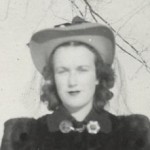
 My aunt, Ruth Wolfe was the person I most closely resembled. She was my dad, Allen Spencer’s sister, and for most of my life, I didn’t really know that I resembled her. Nevertheless, I am built like she was. I laugh like she did, something I found out after she passed away, and I laughed, but when I did, I heard her laughing. I thought, “How could that be?” I had never noticed that I laughed like her before. I began to wonder how I hadn’t noticed it before. Whatever the reason, I did and do laugh like her, and these days, it is a pleasant reminder of her, and the memories are very sweet.
My aunt, Ruth Wolfe was the person I most closely resembled. She was my dad, Allen Spencer’s sister, and for most of my life, I didn’t really know that I resembled her. Nevertheless, I am built like she was. I laugh like she did, something I found out after she passed away, and I laughed, but when I did, I heard her laughing. I thought, “How could that be?” I had never noticed that I laughed like her before. I began to wonder how I hadn’t noticed it before. Whatever the reason, I did and do laugh like her, and these days, it is a pleasant reminder of her, and the memories are very sweet.
I always loved Aunt Ruth…and her husband, Uncle Jim too. They lived what seemed like such an exciting life. When they moved away from Casper, Wyoming, they moved to Reno, Nevada, and later to Vallejo, California, and finally to Newport, Washington. While Washington was rather a calm place, almost a retirement of sorts, Reno and Vallejo seemed like an exciting, party kind of place…and maybe it was. People go through different 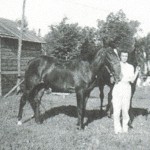
 phases in life, and maybe they were in a phase of looking for some excitement. A small town, like Casper, Wyoming, while not tiny, is certainly not as exciting as a place like Reno, Nevada or Vallejo, California. Still, Newport, Washington, and especially the mountain top property they purchased, was certainly more like the places she lived when she was growing up. It was almost like going back to her roots.
phases in life, and maybe they were in a phase of looking for some excitement. A small town, like Casper, Wyoming, while not tiny, is certainly not as exciting as a place like Reno, Nevada or Vallejo, California. Still, Newport, Washington, and especially the mountain top property they purchased, was certainly more like the places she lived when she was growing up. It was almost like going back to her roots.
I think that some of the happiest times in Aunt Ruth’s life were when she and Uncle Jim were on the road, traveling. They liked to see the world around them, and they loved showing up unannounced to surprise us. I don’t think they ever thought about the fact that they might find us out of town, and to my knowledge, they never did…or at least if they did, they never told us about it. I suppose if they had told us they were coming, it would have ruined the adventure of things. I don’t think any of us ever minded the 
 surprises that came with their unexpected visits. My parents were always happy that they were there. It was like running into a favorite old friend…but they were old friends, even more so than some siblings are. Aunt Ruth and my dad were just 19 months apart. They were the youngest of my grandparents four children, and in many ways, that did make them close, even though they were brother and sister, and not brother/friends, like my dad and their older brother, my Uncle Bill. Today would have been my Aunt Ruth’s 97th birthday. Happy birthday in Heaven, Aunt Ruth. We love and miss you very much.
surprises that came with their unexpected visits. My parents were always happy that they were there. It was like running into a favorite old friend…but they were old friends, even more so than some siblings are. Aunt Ruth and my dad were just 19 months apart. They were the youngest of my grandparents four children, and in many ways, that did make them close, even though they were brother and sister, and not brother/friends, like my dad and their older brother, my Uncle Bill. Today would have been my Aunt Ruth’s 97th birthday. Happy birthday in Heaven, Aunt Ruth. We love and miss you very much.

 When the Transcontinental Railroad opened in 1869, the people in the east finally had the chance to take a trip into the Wild West without having to move there or plan on spending months there visiting family. I can imagine that there were mixed emotions involved as they headed out. The Western dime novels had told of wild Indians, gunslingers, bank robberies, and of course, train robberies. It was almost enough to make them question the sanity of their intended trip into the wild, but nevertheless, they went.
When the Transcontinental Railroad opened in 1869, the people in the east finally had the chance to take a trip into the Wild West without having to move there or plan on spending months there visiting family. I can imagine that there were mixed emotions involved as they headed out. The Western dime novels had told of wild Indians, gunslingers, bank robberies, and of course, train robberies. It was almost enough to make them question the sanity of their intended trip into the wild, but nevertheless, they went.
One of the great misconceptions of the Wild West is that it maybe wasn’t quite as wild as the Easterners had been told. In fact, the town of Palisade, Nevada, a state notoriously known for its wildness these days, like many other Wild West towns of the time, was actually very peaceful. In fact, the town had so few crimes that it didn’t even have an official sheriff. So, when the train began running through Palisade, and the train conductor  told the townspeople that railroad passengers were often disappointed at how these quiet towns were so different from how they were portrayed in the Western dime novels, he people of Palisade decided that something had to be done.
told the townspeople that railroad passengers were often disappointed at how these quiet towns were so different from how they were portrayed in the Western dime novels, he people of Palisade decided that something had to be done.
The townspeople, with the full knowledge and approval of the citizens of the town, the US Cavalry, and even a local Indian tribe, staged Western-style shootouts in the street, bank robberies, Indian battles, and whatever else they could think of. The whole purpose was to provide entertainment for the passing railroad travelers. After the train passed, life in the small town went back to its “dull, quiet, and peaceful” normal. I don’t know if the purpose was to bring in more tourists, to save face when it came to the Western dime novels, or maybe just to have a good laugh at the expense of the city-slickers. The reality is that many of the people back east, at that time, felt like their way of life was better than the “craziness” of the Wild West, and that to go have a look was a way of not only entertaining themselves, but also to prove that the West could not possibly be a peaceful place to live. Of course, while things could be violent and wild in the old West, it wasn’t always that 
 way. It’s also a possibility that the people had moved to the West wanted the people in the East to think that the West was a wild place, full of adventure. It was the whole purpose for going west anyway, wasn’t it…to find that adventure? Yes, that was the purpose for the move to the West. And that purpose had to be protected, by any means necessary…even theater.
way. It’s also a possibility that the people had moved to the West wanted the people in the East to think that the West was a wild place, full of adventure. It was the whole purpose for going west anyway, wasn’t it…to find that adventure? Yes, that was the purpose for the move to the West. And that purpose had to be protected, by any means necessary…even theater.
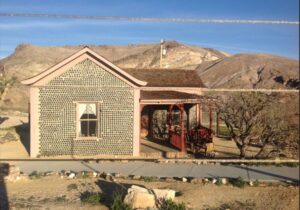
 When we think of structures that have stood the test of time, we think of stone structures or structures made out of hard woods that are able to weather the elements, but sometimes a structure defies the normal expectations, as stands the test of time against all odds. There is a house in the ghost town of Rhyolite, Nevada that is the perfect example of that kind of structure.
When we think of structures that have stood the test of time, we think of stone structures or structures made out of hard woods that are able to weather the elements, but sometimes a structure defies the normal expectations, as stands the test of time against all odds. There is a house in the ghost town of Rhyolite, Nevada that is the perfect example of that kind of structure.
A local saloon owner named Tom Kelly decided to build a house in 1906. Unfortunately, lumber was scarce in the area at the time, so the innovative 76-year-old saloon owner decided to use the materials at hand to build his house…bottles. Not many people would have come up with such an idea, much less have the ability to carry out the strange design and actually make it a house. An estimated 50,000 beer, whiskey, soda, and medicine bottles were used to build the structure, and amazingly, it is still standing today. Tom Kelley was 76 years old when he built the house that took him almost six months to complete. Thankfully he didn’t have to drink all the alcohol in those 50,000 bottles. The bottle house also sports a “garden” of sculptures made of broken glass  including miniature houses, bottle ropes, and a host of other “glass treasures” that would probably qualify as junk to most of us, but they seem to fit the bottle house perfectly.
including miniature houses, bottle ropes, and a host of other “glass treasures” that would probably qualify as junk to most of us, but they seem to fit the bottle house perfectly.
There was a period of time when the house was in some disrepair, but amazingly it was things like needing a new roof that caused the disrepair, not broken bottles in the structure. In 1925, Paramount Pictures wanted to use the house in a movie, so as part of the deal, they restored and re-roofed the house. The house, which really is pretty cute, was given to the Beatty Improvement Association for maintenance as a historical site. That might be part of why it still stands today, but the work that went into it originally was a big part of the house’s ability to stand the test of time.
Louis J Murphy leased and maintained the house as a museum that he ran with a woman named Bessie Stratton Moffat until he died in 1956. Later, a man named Tommy Thompson and his wife lived in the house, while maintaining a museum and a relic shop. How unique it must have been to live in such a house. No, it’s not a big house, and probably doesn’t have a monetary value that would rival today’s market, but its value really lies in a different area. The house fit the Thompsons, however. Tommy was a musician, who worked 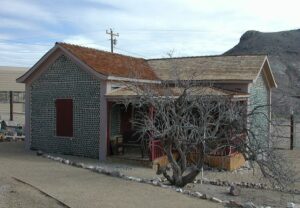
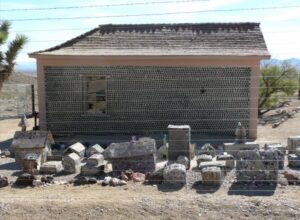 playing the accordion in the saloons in Rhyolite back when it was a boomtown. Evan Thompson maintained the house for a while after his parents died. He is the last person to actually live in the house, but he finally moved on, living in Pioneer, Nevada now. Once again, the bottle house stands empty, no longer in use, but still as resilient as ever.
playing the accordion in the saloons in Rhyolite back when it was a boomtown. Evan Thompson maintained the house for a while after his parents died. He is the last person to actually live in the house, but he finally moved on, living in Pioneer, Nevada now. Once again, the bottle house stands empty, no longer in use, but still as resilient as ever.
 I can imagine a number of nicknames a stagecoach driver might want to have, one that no one would want to have. George Green was one of the most popular stagecoach drivers in the Sierra Mountain Range, driving for the Pioneer Stage Company between Placerville, California and Virginia City, Nevada in the 1860s. George had the nickname “Baldy” because of the sparse amount of hair he had on the top of his head. It was not the nickname “Baldy” that George would learn to hate, however. George was known for his good looks, standing about six feet tall with a large full mustache, but it was not his good looks or large mustache that earned him the nickname he hated either.
I can imagine a number of nicknames a stagecoach driver might want to have, one that no one would want to have. George Green was one of the most popular stagecoach drivers in the Sierra Mountain Range, driving for the Pioneer Stage Company between Placerville, California and Virginia City, Nevada in the 1860s. George had the nickname “Baldy” because of the sparse amount of hair he had on the top of his head. It was not the nickname “Baldy” that George would learn to hate, however. George was known for his good looks, standing about six feet tall with a large full mustache, but it was not his good looks or large mustache that earned him the nickname he hated either.
During his days as a stagecoach driver, Green drove many famous people including Ben Holladay, Horace Greeley, and Vice-President Schuyler Colfax. Nevertheless, Green was apparently not a very scary driver. On May 22, 1865, near Silver City, Nevada, three men robbed his stage of $10,000 in gold and greenbacks. I guess word must have gotten around, because more robberies followed that first one, and not only would the robbers not leave him alone, but the robberies were big news and the stories sold lots of newspapers. The Territorial Enterprise commented that Green had narrowly escaped scalping, and someone placed a sign near the robbery location saying, “Wells-Fargo Distributing Office, Baldy Green, Mgr.”
Green just couldn’t catch a break. Two years later his stage was robbed twice on successive days, and following another robbery on June 10, 1868, Virginia City’s Territorial Enterprise stated: “Baldy Green is exceedingly unlucky, as the road agents appear to have singled him out as their special man to halt and plunder, and they always come at him with shotguns.” Two more robberies occurred the same month, and you might say that the  writing was on the wall. No one came right out an accused Green of being involved, but it had come to the point that they couldn’t take the risk of keeping him on anymore. Green was fired. Whether he was guilty or not, he was the driver most likely to be robbed. While he was never given that nickname, it is rather a fitting one.
writing was on the wall. No one came right out an accused Green of being involved, but it had come to the point that they couldn’t take the risk of keeping him on anymore. Green was fired. Whether he was guilty or not, he was the driver most likely to be robbed. While he was never given that nickname, it is rather a fitting one.
Green didn’t let that stop him, however. He then went to hauling freight in Pioche, Nevada. I guess either he figured out how to stop the robberies, or freight haulers were less likely to be robbed. Either way, he managed to have more success in that trade that the stagecoach career. Later on, he even served as Justice of the Peace in Humboldt County, Nevada.

 The Gold Rush affected many states and many people. Everyone headed west to try their luck, hoping to strike it rich. While the big strikes seemed to be in California, the Black Hills, and Alaska, there were many other places where miners struck it rich…and just as many where the miners went bust. It takes a special group of people to persevere in the gold rush years, and many went home broke, or found another way to cash in on the god rush, such as stores where the miners could buy supplies, or saloons, where they could drown their sorrows.
The Gold Rush affected many states and many people. Everyone headed west to try their luck, hoping to strike it rich. While the big strikes seemed to be in California, the Black Hills, and Alaska, there were many other places where miners struck it rich…and just as many where the miners went bust. It takes a special group of people to persevere in the gold rush years, and many went home broke, or found another way to cash in on the god rush, such as stores where the miners could buy supplies, or saloons, where they could drown their sorrows.
Wyoming had it’s share of gold mines and gold strikes too. Atlantic City was located in west central Wyoming, it was one of three mining towns in the area. The others were South Pass City, and Hamilton City. These towns sprung up as a result of the gold discovery at Spring Gulch in 1867. Hamilton City is located about three miles east of Atlantic City, but it could prove very difficult to locate, because early on in the town’s history, the townspeople unofficially renamed it to Miners Delight after the area’s largest and most productive mine, which carried the same name and was located on Peabody Hill.
The Miners Delight mine was founded by Jonathan Pugh. After a while, the town was officially changed to Miners Delight, since no one called it Hamilton City anyway. At first the mine was a rich enough producing mine to warrant a 10-stamp mill to be erected to crush the rock. The first mention of the town in newspapers appeared in July 1868 with the Sweetwater Mines newspaper describing it as: “…some thirty buildings are up, and more in course of construction. Spring Gulch is turning out the bright ore in very comfortable quantities,” and continues “Ten companies are at work in Spring Gulch…and all appear content with the result of their labors.”
Strangely, the owners of the Miners Delight mine found that recovering gold is more expensive than the gold is worth. After a short few years, the town’s population fell dramatically from its peak of some 75 residents. The Miners Delight Mine shut down in 1874, but soon reopened again…only to close again in 1882. The mining camp would endure good times and bad times over the next several decades, including the Great Depression. Over the years the mine produced over $5 million in gold ore…a relatively small amount as gold goes. The town was inhabited as late as 1960, but today it is nothing but abandoned ruins.
If you go there, you can expect to see rusting iron equipment, such as this old stove, and a couple of iron box screens, around the cabins of Miners Delight, Wyoming. It all seems like nothing much, but in the town’s heyday, it was even home to a couple of famous residents. Henry Tompkins Paige Comstock, would later discover the famous Comstock Lode in Nevada, and a young orphaned girl named Martha Jane Canary, who became known a Calamity Jane. As a child, Marth was adopted and moved with her new parents to Miners Delight. She liked the wild life in both Atlantic City and Miners Delight, and then in Deadwood, South Dakota.

 Today, the site is located on Bureau of Land Management property. Some preservation work has been done in order to keep the few remaining buildings standing, but the site is not being restored. Miners Delight is listed on the National Register of Historic Places. The site continues to preserve several cabins, one building that was said to have been a saloon, a baker, a barn, and a couple of outhouses. They are the last remnants of a long ago era.
Today, the site is located on Bureau of Land Management property. Some preservation work has been done in order to keep the few remaining buildings standing, but the site is not being restored. Miners Delight is listed on the National Register of Historic Places. The site continues to preserve several cabins, one building that was said to have been a saloon, a baker, a barn, and a couple of outhouses. They are the last remnants of a long ago era.

